Can moons have their own moons?
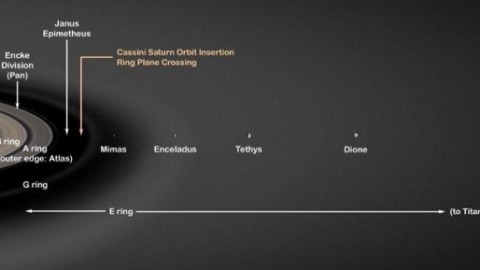
This isn’t an XZibit joke; it’s a real scientific question. And the answer may be that it’s possible after all.
“People who work every day are kind of scared of things they don’t understand.” –Young Jeezy
In the Solar System, we have the central Sun, a great many planets, asteroids, Kuiper belt objects, and moons. While most of the planets have moons, and some of the Kuiper belt objects and even asteroids have natural satellites that orbit them, there are no known “moons of moons” out there. It may not be because we’re just unlucky; there may be some fundamentally important rules of astrophysics that make it extraordinarily difficult for such an object to stably exist.
When all you’ve got is a single, massive object in space to consider, everything seems pretty straightforward. You’d intuit that gravitation would be the only force at work, and so you’d be able to place any object into a stable, elliptical-or-circular orbit around it. Under that setup, you’d expect that it would continue on that way forever. But there are other factors at play, including the fact that:
- this object can have some sort of atmosphere, or a diffuse “halo” of particles around it,
- this object isn’t necessarily stationary, but can spin — perhaps rapidly — about an axis,
- and that this object isn’t necessarily as isolated as you initially imagined.
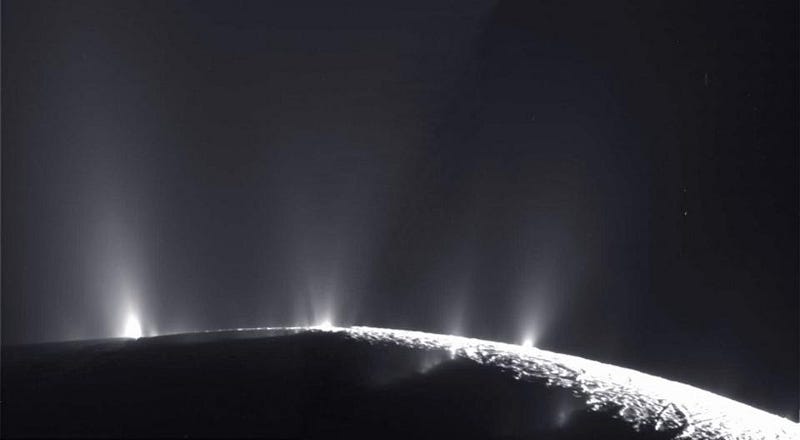
The first factor, an atmosphere, only matters in the most extreme of cases. Normally, an object orbiting a massive, solid world with no atmosphere would simply need to avoid the object’s surface, and it could remain revolving around it forever. But if you throw in the presence of an atmosphere, even an incredibly diffuse one, any orbiting bodies will have to contend with those atoms and particles surrounding the central mass.
Even though we normally think of our atmosphere as having an “end” and space beginning beyond a certain altitude, the reality is that atmospheres simply thin out as you go to higher and higher elevations. Earth’s atmosphere continues for many hundreds of kilometers; even the international space station will someday decay and meet a fiery doom unless we continually boost it. Over Solar System timescales of billions of years, the point is that orbiting bodies need to be a certain distance away from whatever mass they orbit in order to be “safe.”
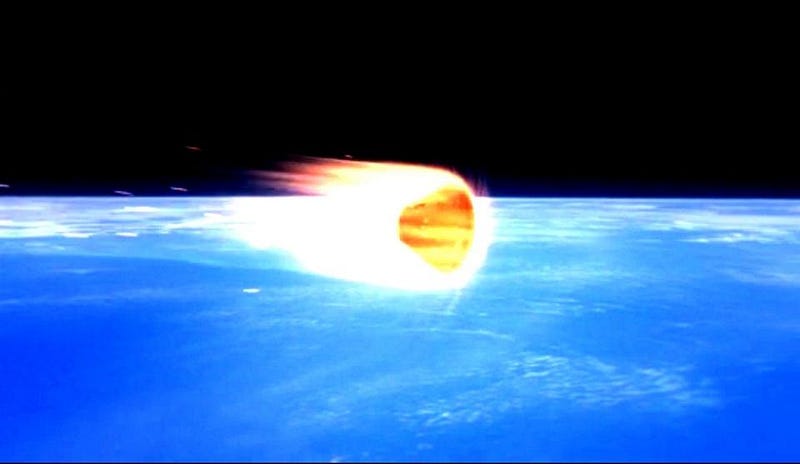
Additionally, an object can spin. This applies to both the large mass and the smaller one orbiting it. There’s a “stable” point, where both masses are tidally locked to one another (where both of them always have the same side pointing to one another), but if you have any other configuration, there will be some “torquing” happening. This torque can work to either spiral the two masses inwards (if the rotation is too slow) or outwards (if the rotation is too fast) for the locking to occur. In other words, most satellites don’t start off in the ideal configuration! But there’s one more factor that we need to throw in to get to the issue of “moons of moons” and really see where the difficulty lies.
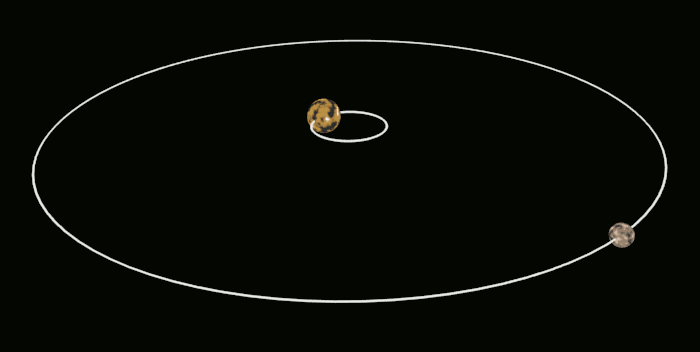
The fact that an object isn’t isolated is a really big deal. It’s a lot easier to keep an object in orbit around a single mass — like a moon around a planet, a small asteroid around a large one, or Charon around Pluto — than it is to keep an object in orbit around a mass that itself orbits another mass. This is a huge factor, and isn’t one we normally consider. But think about it for a moment from the perspective of our innermost, moonless planet, Mercury.

Mercury orbits our Sun relatively quickly, and hence both the gravitational and tidal forces on it are very large. If there were something else orbiting Mercury, there would now be a large number of additional factors at play
- The “wind” from the Sun (the flow of outward particles) would crash into both Mercury and the object orbiting it, perturbing the orbits.
- The heat that the Sun applies to Mercury’s surface can result in an extension of Mercury’s atmosphere. Even though Mercury is airless, particles on the surface get heated and thrown into space, creating a tenuous but non-negligible atmosphere.
- And finally, there’s a third mass in there that wants to cause the ultimate tidal lock: to have not only that small mass and Mercury locked to one another, but to have Mercury locked to the Sun.
This means that, for any satellite of Mercury, there are two limiting locations.
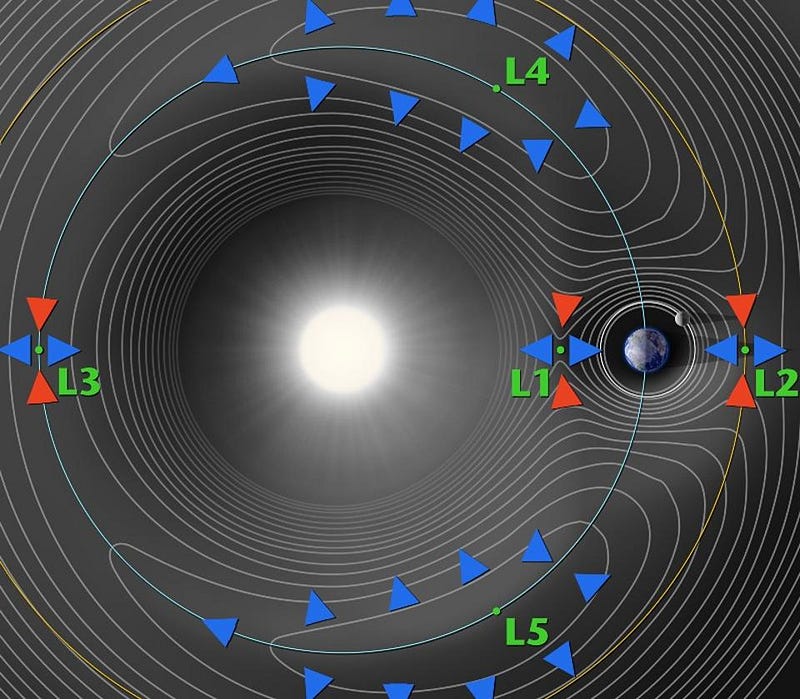
If the satellite is too close to Mercury in any number of ways:
- the satellite is not rotating fast enough for its distance,
- Mercury isn’t rotating fast enough to achieve tidal lock with the Sun,
- susceptible to slowdown from the solar wind,
- or subject to sufficient friction from the Mercurian atmosphere,
it will eventually crash into Mercury’s surface.

And on the flipside, it risks being ejected from Mercury’s orbit by being pushed away if the satellite is too distant and other considerations apply:
- the satellite rotates too quickly for its distance,
- Mercury rotates too quickly to become locked with the Sun,
- the solar wind imparts additional speed to the satellite,
- the perturbative effects of other planets work to eject a tenuously held moon or satellite,
- or heating from the Sun imparts additional kinetic energy to a sufficiently small satellite.
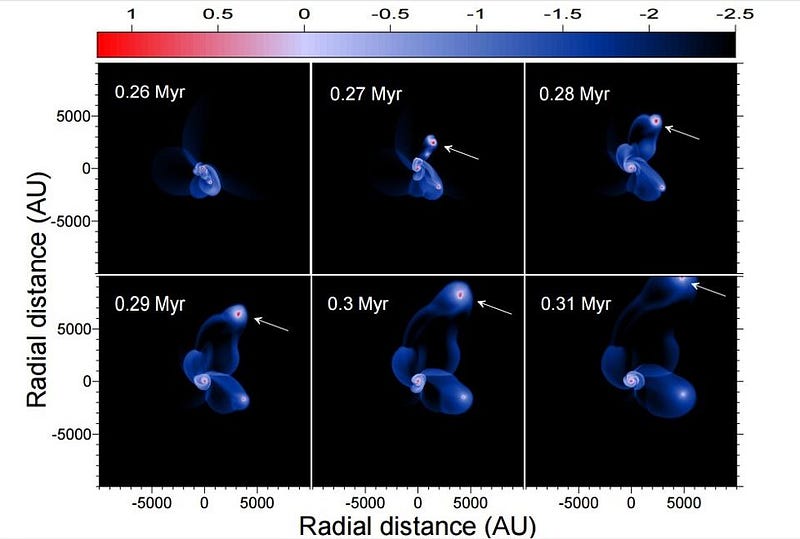
Now, with all that said, there are planets out there with moons! While a three-body system is never truly stable unless you’re in that perfect configuration alluded to earlier, we can achieve stability on timescales of billions of years under the right circumstances. There are a few conditions that make it easier:
- Have the planet/asteroid that’s the main mass of the system be sufficiently far away from the Sun so that the solar wind, the flux of sunlight and the Sun’s tidal forces are all small.
- Have the satellite of that planet/asteroid be close enough to the main body so that it isn’t too loosely bound, gravitationally, so that it’s unlikely to be kicked out from other gravitational or mechanical interactions.
- Have the satellite of that planet/asteroid be far enough from the main body so that tidal, frictional or other effects won’t cause it to inspiral and merge with the parent body.
As you may have guessed, there’s a “sweet spot” for moon to exist around planets: a few times farther away than the planet’s radius, but close enough in that the orbital period isn’t too long: still significantly shorter than the planet’s orbital period around its star. So with all of this in mind, where are the satellites of moons in our solar system?
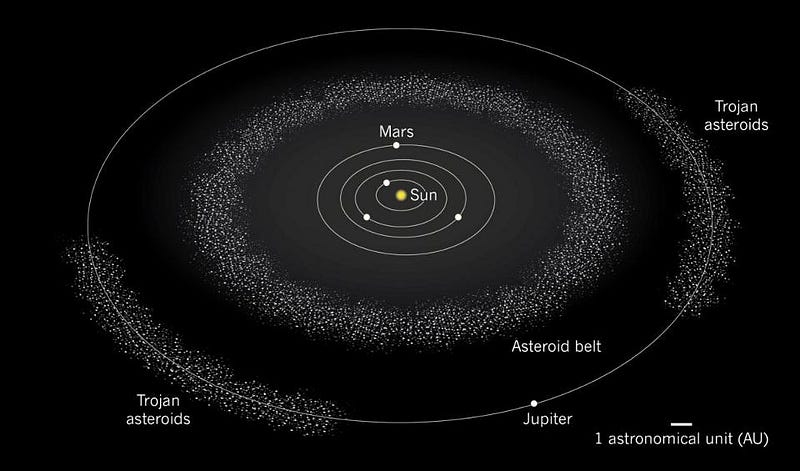
The closest thing we have is that we have trojan asteroids with satellites of their own, but since none of these are “moons” of Jupiter, that doesn’t quite fit the bill. What then?
The short answer is, we’re unlikely to see one at all, but there is hope. The gas giant worlds are pretty stable, and pretty far away from the Sun. They have plenty of moons, many of which are already tidally locked to their parent world. The largest moons are the best candidates we have for housing satellites. The best candidates would be:
- as massive as possible,
- relatively far away from the parent body to minimize the inspiral risk,
- not so far away that there’s a chance of an easy ejection,
- and — this is a new one — well-separated from any other moons, rings, or satellites that could perturb your system.
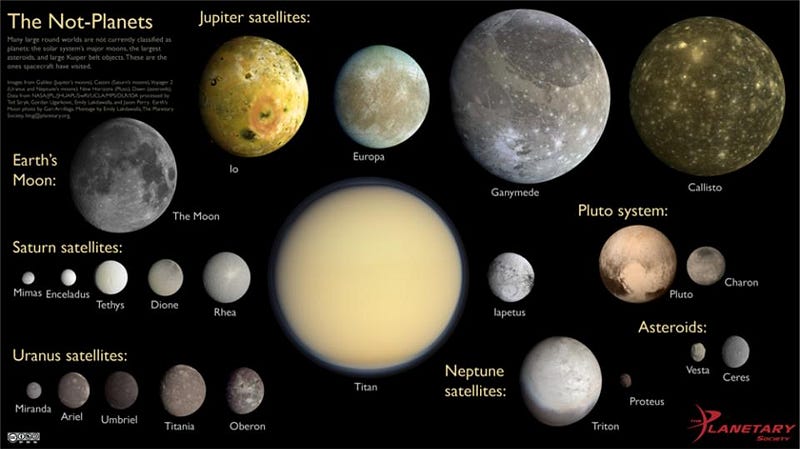
With all of that said, what are the best candidates for moons in our Solar System that might have stable moons of their own?
- Jupiter’s moon Callisto: the outermost of all Jupiter’s major satellites at 1,883,000 km, Callisto is also large with a radius of 2,410 km. It takes relatively long to orbit Jupiter at 16.7 days, and has a sizable escape velocity of 2.44 km/s.
- Jupiter’s moon Ganymede: the biggest moon in the solar system (2,634 km in radius), Ganymede is far from Jupiter (1,070,000 km), but possibly not far enough. (It’s only another 50% of the distance outer to Europa’s orbit.) It has the highest escape velocity of any of the Solar System’s moons (at 2.74 km/s), but the highly populated jovian system makes it less than likely that any of Jupiter’s satellites have moons.
- Saturn’s moon Iapetus: it’s not that big (734 km in radius), but Iapetus is far from Saturn at a mean orbital distance of 3,561,000 km from our ringed planet. It’s well outside of Saturn’s rings and well-separated from all the other major moons. The downside is its low mass and size: you only need to travel at 573 meters-per-second to escape Iapetus’ surface.
- Uranus’ moon Titania: at 788 km in radius, it’s Uranus’ largest moon, located some 436,000 km from Uranus and taking 8.7 days to orbit.
- Uranus’ moon Oberon: Uranus’ second largest (761 km) but most distant (584,000 km) large moon, it takes 13.5 days to orbit Uranus. Oberon and Titania, however, are dangerously (and possibly prohibitively) close to one another to allow for a “moon-of-a-moon” to happen around Uranus.
- Neptune’s moon Triton: this captured Kuiper Belt Object is huge (1,355 km in radius), distant from Neptune (355,000 km) and massive; an object needs to travel at over 1.4 km/s to escape Triton’s gravity. This would, perhaps, be my best “bet” for a moon of a planet that had its own natural satellite.
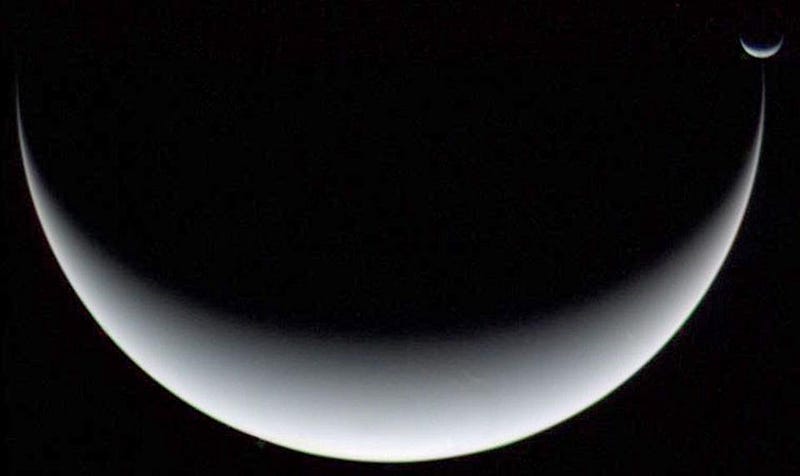
But with all of that said, I wouldn’t expect any. The conditions to acquire and retain a moon-of-a-moon all pose extreme difficulties when you consider how many gravitationally perturbative objects there are in these gas giant systems. If I had to place bets, I’d say Iapetus and Triton were the most likely candidates for having a “moon-of-a-moon,” since they’re the farthest main satellites of their world, they’re somewhat isolated from other large masses, and the escape velocity from the surface of each of those worlds is still fairly substantial.
But with all that said, to the best of our knowledge, we still don’t know of any. Perhaps this reasoning is all wrong, as well, and our best bet will actually be in the far reaches of the Kuiper Belt or even the Oort Cloud, where we simply have so many more chances than we’d ever get in our Solar System.
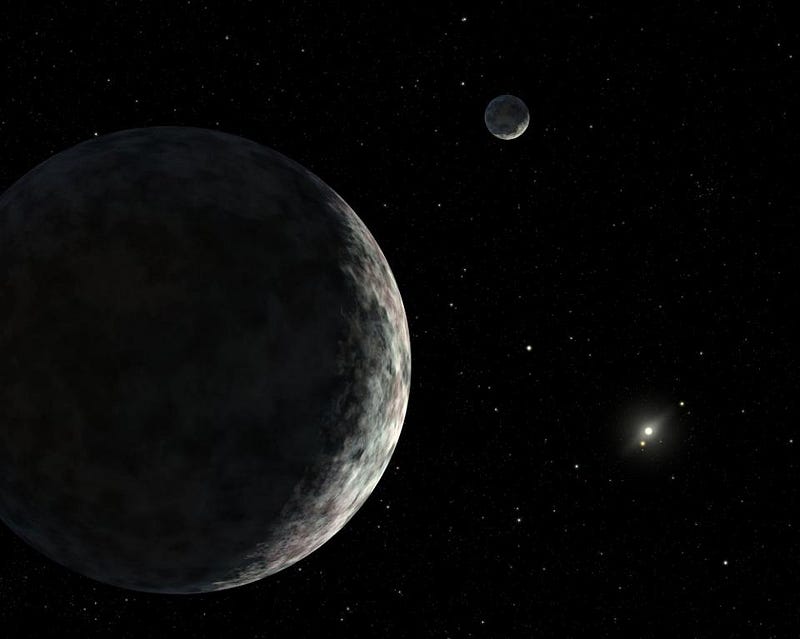
To the best of our knowledge, these objects could exist: it’s possible, but it requires very specific conditions that would take a fair bit of serendipity. As far as our observations go, that serendipity didn’t occur in our Solar System. But you never know: the Universe is full of surprises. And the better our capabilities to look become, the more we tend to find. I wouldn’t be too surprised if the next great mission to Jupiter (or other gas giants) uncovered this exact phenomenon! Perhaps moons-of-moons are real, and it just takes a fortunate look in the right place to uncover them.
Ethan Siegel is the author of Beyond the Galaxy and Treknology. You can pre-order his third book, currently in development: the Encyclopaedia Cosmologica.





